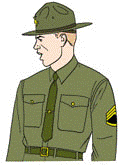United States Department of Defense
Date of this Version
3-26-1943
Document Type
Article
Abstract
The members of the Adjutant General’s Department were the administrative officers of the Army. With the assistance of a large numbers of clerks and other assistants, they had monumental task of generating the paperwork necessary to organize thousands of military units, bases, air fields, and other facilities; to move officers and soldiers around to staff those organizations, and to move units from place to place. The Adjutant General’s School had the task of training numerous adjutants.
This text explains the differences between the various types of orders, explains the details of framing each correctly, and urges adjutants to write clearly and concisely. It provides numerous examples of the various types of orders and the various uses they are put to.
The text explains that:
A) General orders should be used for important matters – often concerning organizations -- which are directive in nature and permanent in duration and to announce major events like the death of a President. For examples, War Department General Orders 38, 1942, established the Transportation Corps, under the Chief of Transportation who reported to the Commanding General, Army Service Forces.
B) Special orders concern personnel – individuals or groups, are directive in nature, and are either permanent or temporary in duration. For example special orders may be used to direct appointments, assignments, promotions, transfers, etc.
C) Memorandums, circulars, and bulletins are used for announcements of less gravity than general and special orders. One common example is daily bulletins widely used in the Army.
The text stresses the importance of writing clear, concise orders. The authors were fond of quoting Kipling’s “Six Honest Serving Men:”
I keep six honest serving men
(They taught me all I knew);
Their names are What and Why and When
And How and Where and Who…
It contains much good advice about clear writing. However, to the modern reader, some of the examples appear to be stilted and formulaic.



Comments
(1) This is an unnumbered, unofficial text book used at the Adjutant General’s School, Fort Washington, MD, during World War II.
(2) This is an excellent resource for scholars and others trying to understand World War II era military records.
(3) This is a digital copy of the text book borrowed from the Ball State University Libraries.